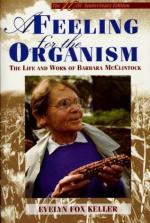
|
| Name: _________________________ | Period: ___________________ |
This test consists of 15 multiple choice questions and 5 short answer questions.
Multiple Choice Questions
1. In Chapter 1, it is mentioned that immune systems were studied in what animal?
(a) Rats.
(b) Dogs.
(c) Rabbits.
(d) Mice.
2. Who wrote the book, Embryology and Genetics?
(a) C.D. Darlington.
(b) L.C. Dunn.
(c) Barbara McClintock.
(d) T.H. Morgan.
3. What did Barbara McClintock receive her PhD in?
(a) Genetics.
(b) Botany.
(c) Cytology.
(d) Zoology.
4. What year did Barbara McClintock graduate from Cornell?
(a) 1923.
(b) 1920.
(c) 1932.
(d) 1941.
5. What did Barbara's uncle do for a living?
(a) He was a fish dealer.
(b) He was a farmer.
(c) He was a scientist.
(d) He was a baker.
6. There was a gap that appeared in Barbara's list of publications. In what year did she not publish anything?
(a) 1938.
(b) 1935.
(c) 1936.
(d) 1939.
7. When Barbara went to visit Stadler in Missouri, she went to look at the corn that they had. Barbara noticed that they were calling the corn what?
(a) Ring chromosome plants.
(b) Transfusion treat.
(c) McClintock corn.
(d) Barbara plants.
8. When McClintock speaks about having no chance of being promoted she states that she was excluded from what?
(a) Weekend get-togethers.
(b) Decisions about the department.
(c) Faculty meetings.
(d) Class time with other professors.
9. Darlington described that in an adaptive hierarchy the chromosomes always come first. What comes second?
(a) Organisms.
(b) Transposed cells.
(c) Second generation chromosomes.
(d) Genes.
10. A problem that had caught Barbara's fancy was a small body on the end of what chromosome?
(a) Chromosome 9.
(b) Chromosome 2.
(c) Chromosome 3.
(d) Chromosome 6.
11. What was the word or words that Barbara used in the book to describe a plant that was part dominant and part recessive?
(a) Combined.
(b) Dual matched.
(c) Transfused.
(d) Variegated.
12. George Beadle was a young graduate student from where?
(a) South Dakota.
(b) Kansas.
(c) Nebraska.
(d) Iowa.
13. Who was considered to be the severest critic in the field of genetics during Barbara's time in the field?
(a) Barbara McClintock.
(b) Alfred Sturtevant.
(c) Richard B. Goldschmidt.
(d) Stephen Jay Gould.
14. What did Stadler and McClintock share a keen interest in concerning maize?
(a) The length of its chromosomes.
(b) Its genetic composition.
(c) The length of its generations.
(d) Its ease of study.
15. What was the term that McClintock phrased that meant a capacity to change positions?
(a) Transferration.
(b) Correspondence.
(c) Transposition.
(d) Permutation.
Short Answer Questions
1. What was the name of the book that was published by Morgan, Sturtevant, Muller, and Bridges?
2. In what year was the first woman admitted to Cornell University?
3. Who was Dean of Liberal Arts at Missouri in 1940?
4. What were the names of the flies that were used in studying genetics?
5. One day, why did Barbara climb the side of a building and let herself in a window?
|
This section contains 457 words (approx. 2 pages at 300 words per page) |

|




